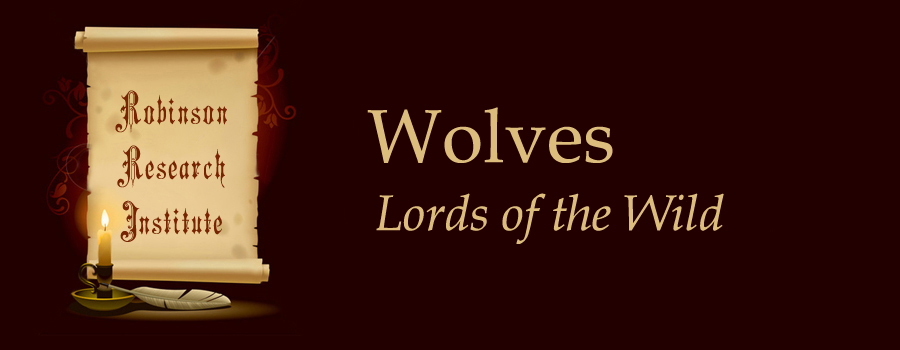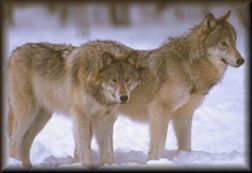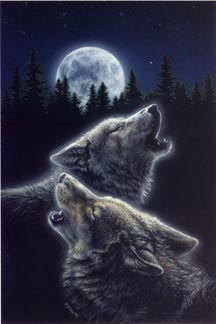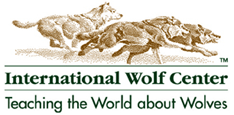|
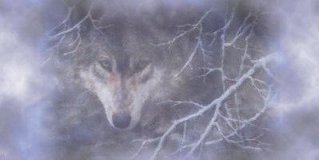 Understanding the Wolf
Understanding the Wolf
The Human Civilization is a force beyond what nature could have ever conceived. It is relentless and unforgiving and cares not what it destroys through its self-acclaimed dominance to justify the reasoning behind progress.
What is the purpose for all the progress? It was thought, at one time, that new discoveries through progress would enhance the quality of life and lessen the hardships of humankind's survival on this planet. Unfortunately, this has not been the case. While following a destructive course to enhance the human quality of life all other life suffered and it suffered to the point of complete elimination. Many forms of life no longer exist because of human progress. Someday, hopefully very soon, humans must wake up to the fact and the truth that if they continue on such a course not only will there be nothing left to destroy but they too will no longer exist.
Time is very short. Of all the things that no longer exist - they will never return. The balance of nature must be cared for by responsible stewards who understand that they too are a very important part of its mysterious workings. No human has the right to offset the laws of the universe or this planet. The arguments between the so-called environmentalists and the corporate complex is like a child arguing with their mother. The earth is our mother...would you rape your own mother or anyone elses? The animals are our brothers and sisters...we are all animals...would you kill your own family? Every thing on this planet is a part of us as we are a part of them...the more we abuse it the more we lose it.
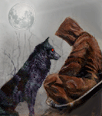 What sort of animal is the wolf that it should rouse such emotions in human beings and set free such energies directed at its destruction? For thousands of years it has been hunted down in almost unparalleled fashion, and it still crops up as a ferocious beast, the very symbol and embodiment of evil, in countless fairy tales, sagas, and proverbs, and in recent times also in films, novels, and travel stories. There is hardly a Russian winter-night's tale that does not include the howling of wolves, and hardly a story from the forests of Canada or Alaska without an attack by a wolf followed by its inevitable killing by the hero.
What sort of animal is the wolf that it should rouse such emotions in human beings and set free such energies directed at its destruction? For thousands of years it has been hunted down in almost unparalleled fashion, and it still crops up as a ferocious beast, the very symbol and embodiment of evil, in countless fairy tales, sagas, and proverbs, and in recent times also in films, novels, and travel stories. There is hardly a Russian winter-night's tale that does not include the howling of wolves, and hardly a story from the forests of Canada or Alaska without an attack by a wolf followed by its inevitable killing by the hero.
 The Laplanders of Scandinavia equate the wolf with the devil, while North American Indians talk of it as their brother. In Western mythology the wolf is not always wholly evil, but is also a symbol of motherliness, love, and self-sacrifice, as in the legend of Romulus and Remus and the founding of Rome. There are Indian legends about so-called "wolf children," allegedly reared by a she-wolf.
The Laplanders of Scandinavia equate the wolf with the devil, while North American Indians talk of it as their brother. In Western mythology the wolf is not always wholly evil, but is also a symbol of motherliness, love, and self-sacrifice, as in the legend of Romulus and Remus and the founding of Rome. There are Indian legends about so-called "wolf children," allegedly reared by a she-wolf.
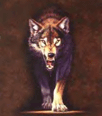 In the competition between man and wolf one should be aware that the competition is one-sided. One humans believe there is a competition and go about their insane business of the complete annihilation of the wolf and their natural habitat. What was once the most widespread of all mammals on Earth is now confined to a small portion of its original territory, at least here in the United States, and here too its persecution continues. Even in areas where it has long since been exterminated the idea of its "crimes," its alleged bloodthirstiness and dangerousness, survives; and, when it appears, all these prejudices are quickly revived.
In the competition between man and wolf one should be aware that the competition is one-sided. One humans believe there is a competition and go about their insane business of the complete annihilation of the wolf and their natural habitat. What was once the most widespread of all mammals on Earth is now confined to a small portion of its original territory, at least here in the United States, and here too its persecution continues. Even in areas where it has long since been exterminated the idea of its "crimes," its alleged bloodthirstiness and dangerousness, survives; and, when it appears, all these prejudices are quickly revived.
It is a rediculous and unacceptable arguement that the wolf is a danger to ranchers livestock...when one runs off the wolf, kills the wolf and their young, hunts their food supply for sport and then builds fences and places other animals within these confinements what would you expect the wolf to do? What would you do if you were hungry? Now, who is the real beast, the real predator? At least the wolf does not hunt for sport nor do they waste anything.
If those who argue that the wolf is an unacceptable danger to their property, livestock and livlihood then perhaps they should quit building feed lots in the wolf's frontyard.
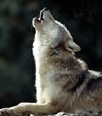 Firm conclusions from studies at the Institute for the Study of Domestic Animals of the University of Kiel in Zürich revealed that on the basis of a large number of skull measurements and examinations of the size and structure of the brain, blood factors, and number of types of chromosomes that all dogs, whether Pekinese, bulldogs, or Alsatians, were descended solely from the wolf and not, as has often been assumed, from the wolf and the jackal.
Firm conclusions from studies at the Institute for the Study of Domestic Animals of the University of Kiel in Zürich revealed that on the basis of a large number of skull measurements and examinations of the size and structure of the brain, blood factors, and number of types of chromosomes that all dogs, whether Pekinese, bulldogs, or Alsatians, were descended solely from the wolf and not, as has often been assumed, from the wolf and the jackal.
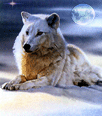 Domestication is a "process of genetic change in an originally wild population of animals and plants when these have been kept genetically isolated from the wild form for many generations in favorable breeding conditions for the use of man." Thus the taming of a single wild animal does not amount to domestication. Many generations of training are required for this. The domesticated wolf is the dog.
Domestication is a "process of genetic change in an originally wild population of animals and plants when these have been kept genetically isolated from the wild form for many generations in favorable breeding conditions for the use of man." Thus the taming of a single wild animal does not amount to domestication. Many generations of training are required for this. The domesticated wolf is the dog.
(The above paragraphs are extracted from: "The Wolf, A Species In Danger - by: German Zoologist Erik Ziman / Published by: Delacorte Press - New York © 1981 All Rights Reserved / ISBN 0-440-09619-7).
 We would also like to offer our readers this other fine work for their continued learning and understanding of the Wolf:
We would also like to offer our readers this other fine work for their continued learning and understanding of the Wolf:
"In Praise of Wolves" by R.D.Lawrence.
Published by: Henry Holt and Company
© 1986 / ISBN 0-03-001597-9
 Thank you for spending a little time with us here on this subject and please visit with us again soon. In the event that you have an article, research paper, photos, links or other related materials that you would like to share with us please send it to us via email.
Thank you for spending a little time with us here on this subject and please visit with us again soon. In the event that you have an article, research paper, photos, links or other related materials that you would like to share with us please send it to us via email.
(No attachments please. We never open those no matter who they are from.)
|
|
|
